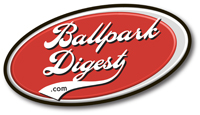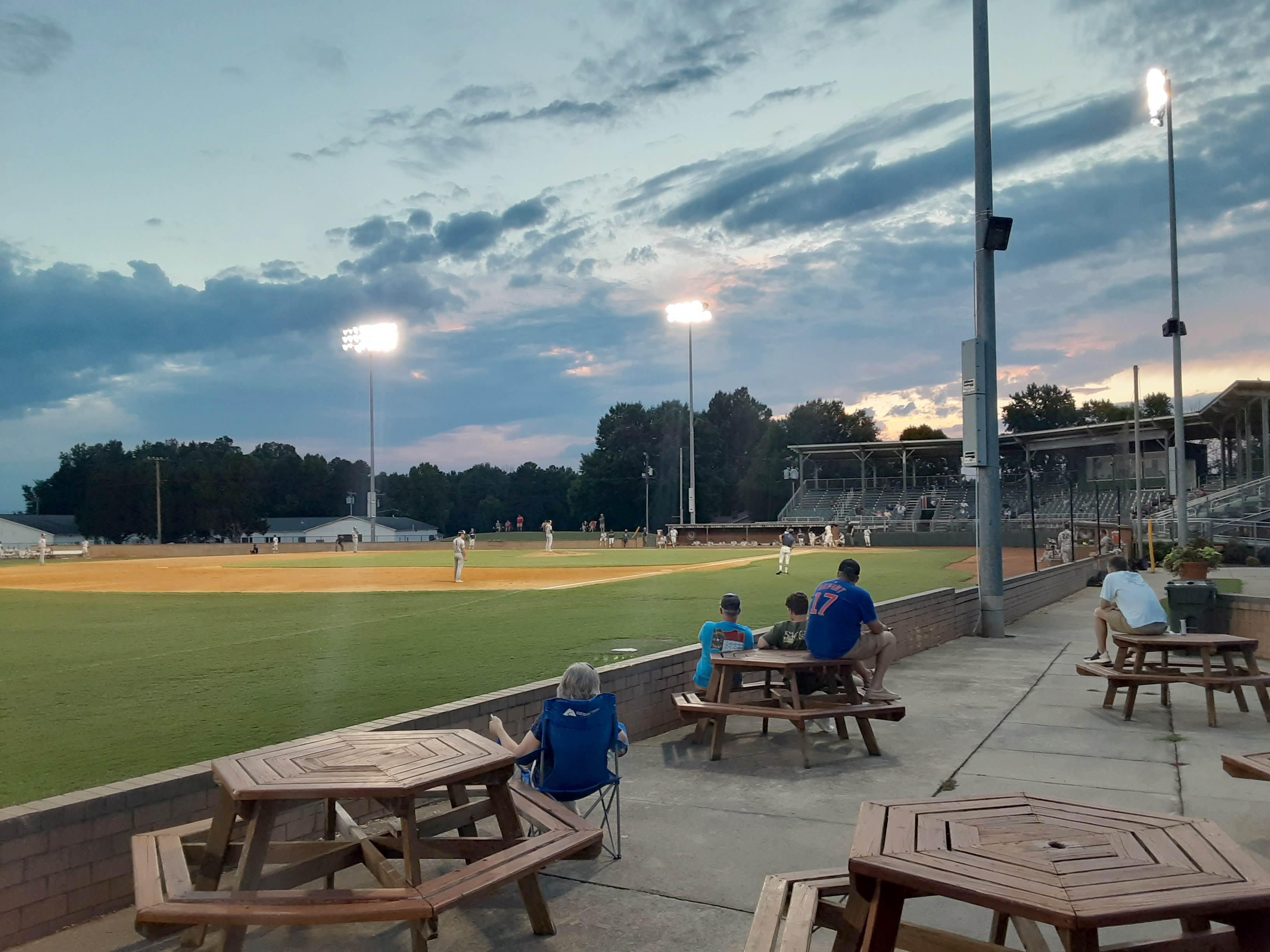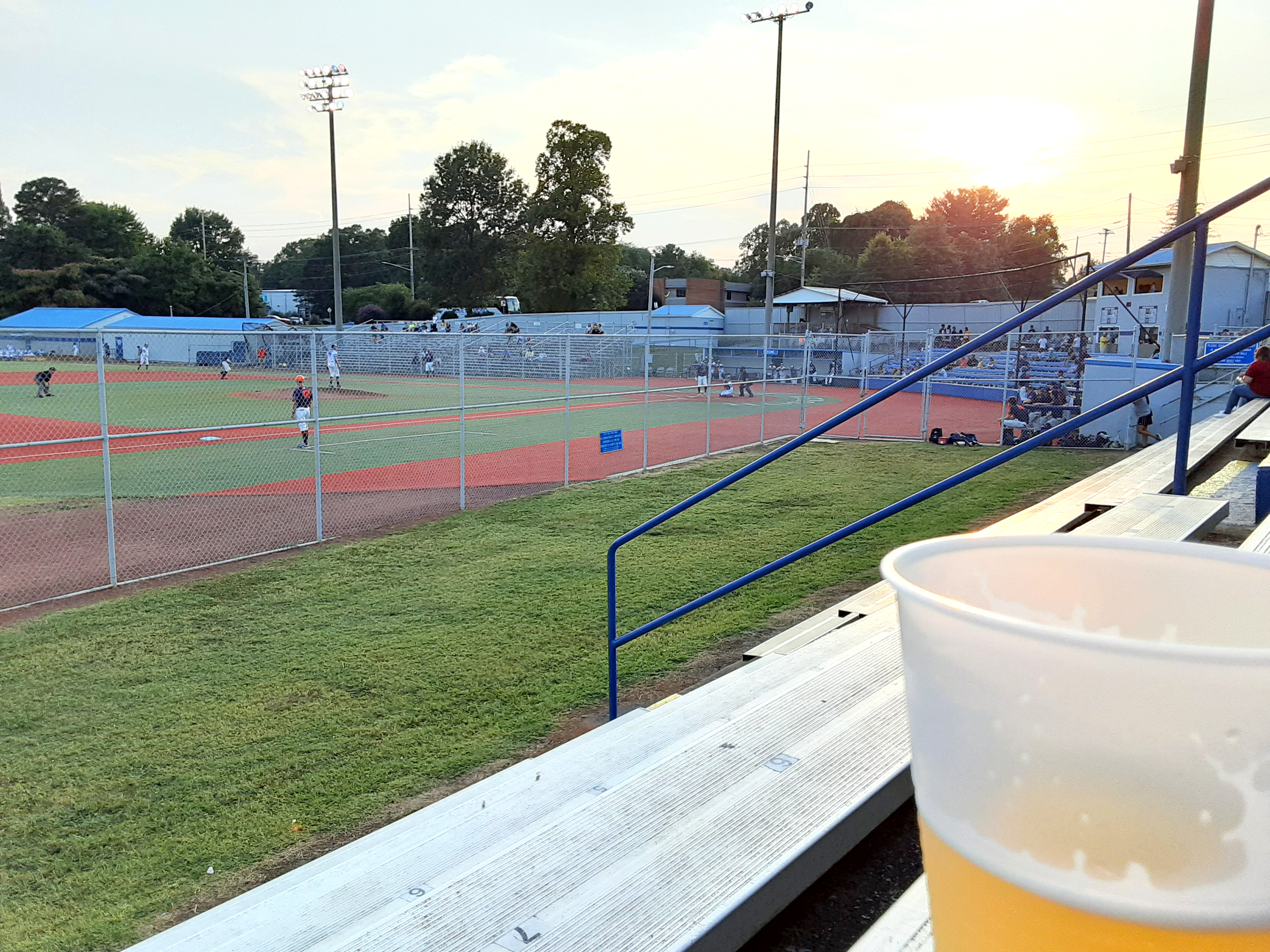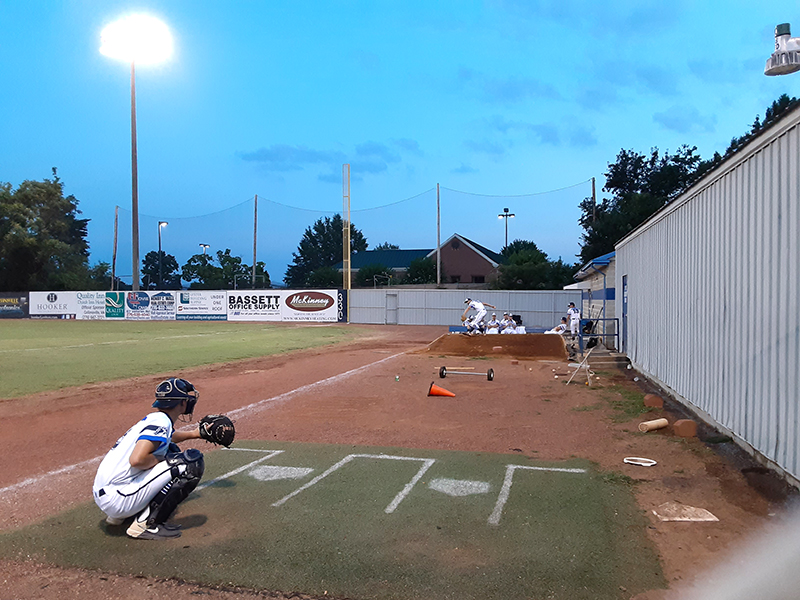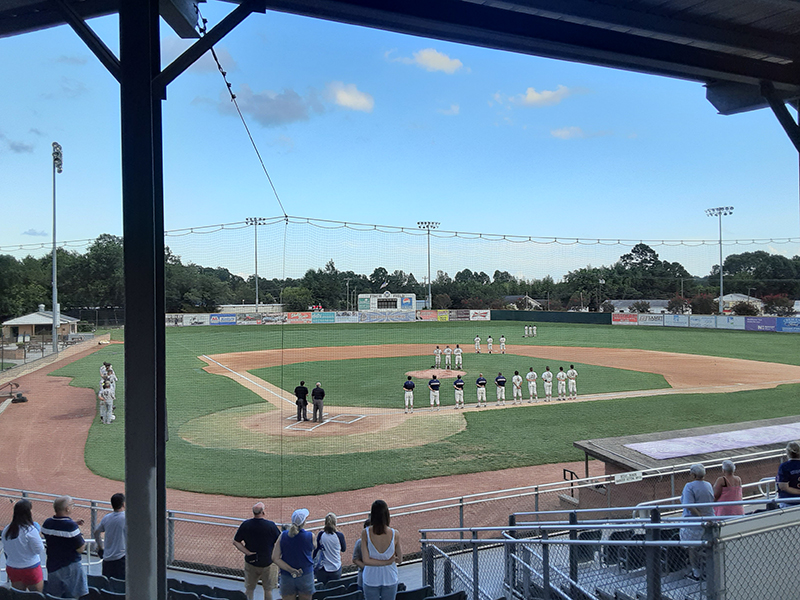With Minor League Baseball shut down for the year and Major League Baseball struggling through a COVID-ridden shortened season in empty ballparks, it’s easy to think of 2020 as a lost season. But competitive baseball is still being played in front of fans in a handful of places. We visit Martinsville and Thomasville.
Seven of the 15 teams in the Coastal Plain League have been playing this summer. Two teams in North Carolina and two teams in Virginia make up the northern pod, while the two Georgia teams and one South Carolina team make up the southern pod. Each team was scheduled to play roughly 20 against the other teams in their pod, and roughly 20 exhibition games against assorted lower-level summer-collegiate teams.
As a baseball fan who cherishes the experience of the ballpark, the return of Major League Baseball has been a nice development, but like many fans, I craved live baseball. With my mask and hand sanitizer in my pockets, I visited Martinsville, VA and Thomasville, NC over the last couple weeks to see what live baseball looked like in the COVID-19 era.
Martinsville
On a recent Thursday night, I made the trip to Martinsville to see the Martinsville Mustangs host the Peninsula Pilots at Hooker Field. The weather was perfect, and it was Thirsty Thursday. Like any baseball fan, I was dying to see some quality baseball in person.
Of course, dying to see baseball is a figure of speech that seems all too real in the era of COVID-19. There are certainly risks to any public event, and varying levels of precautions that can be taken. Coming from North Carolina, where a mandatory mask order is in place, I “masked up” as I got out of my car in the ballpark parking lot. When I approached the ticket window at the Mustangs home field, I had my temperature taken via thermal gun by the ticket seller.
When I entered the park, though, I quickly noticed that I was one of only a small handful of people actually wearing a mask inside the gates. Among the announced crowd of 438, I counted fewer than a dozen masks, including myself, a couple of MLB scouts, and the visiting team bus driver.
There were several PA announcements reminding spectators to engage in social distancing. Point-of-sale locations like the beer counter had clear plastic barriers between staff and customers. Otherwise, it was hard to tell it was the cursed summer of 2020 and not a normal Thursday night. Draft beer was poured, music played, and the fans cheered the home team to victory.
Hooker Field
It was a treat to see two teams on the turf at Hooker Field, a place I had visited several times, but where I had never seen a game. And that grass has been artificial, at least on the infield, since 2015. Built in the 1930s as English Field, the facility was owned by the Hooker Furniture company. The park was deeded to the city in 1988, when it was renamed Hooker Field.
This ballpark has hosted industrial league teams, local amateur baseball, and of course, Minor League baseball. Martinsville has been home to the Coastal Plain League Mustangs since 2005. From 1999 to 2003, this stadium saw its last pro team, the Martinsville Astros of the Rookie-level Appalachian League, who departed for a new facility in Greeneville, Tennessee. Prior to the Astros, Martinsville had a 12-year run with the Phillies affiliate in the short-season Appy League.
The facility is built into a bank at the intersection of Commonwealth Blvd and Chatham Heights Road. There is a small central grandstand behind home plate between the field-level dugouts, and some makeshift box seats on wooden platforms above each dugout.
The beer stand and its small patio area sit above concrete bleachers built into the bank down the third-base line. The general admission seats on the first-base side are freestanding aluminum bleachers.
Fans approach this ballpark from the small parking lot outside the main entrance, which is offset toward third base. A pair of small ticket booths flank this main entrance, and a cinder-block press box and concessions building sit directly behind home plate. This is no grandstand roof, and the backstop is minimal, so think twice about that great parking spot right in front of the gates. You should also pay close attention to every pitch if you are sitting above the dugouts.
Hooker Field is a glimpse into the past. Sitting next door to the historic location of Hooker Furniture, it’s clear that it was squeezed into an existing piece of land bordered by two streets, a la Fenway Park, and it was obviously built piece-by-piece over many decades. As a result, the facility is quirky and unique, but the sightlines in this facility are not great.
There are many odd angles and lots of tall chain link. The field-level dugouts obstruct the view from some of the home plate seats. One of the strangest features is a large, flat grass area that juts out into the field in front of the third-base bleachers, which seems like it should be part of foul territory. This may be useful area for picnic groups or other special events, since there is not much other flat open space in this snug ballpark.
Normality is Thirsty Thursday
The game experience on this beautiful Thursday night was understandably stripped down. There were minimal promotions and contests, and a standard selection of walk-up music and announcements. I did not sample the ballpark cuisine; in light of the pandemic, I stuck to $2 draft beers and a $3 bag of Houston’s fresh roasted salted-in-the shell peanuts, the pride of Dublin, NC.
THOMASVILLE
About ten days later, I was able to attend a game at Thomasville’s Finch Field. The Hi-Toms were hosting the Catawba Stars, who are one of several non-Coastal Plain League teams playing a handful of games against CPL clubs.
This was a beautiful Tuesday night, and while the crowd was very modest, it wouldn’t have been any better during the weekend. North Carolina continues to operate with much tighter restrictions than Virginia, including a maximum of 25 people allowed at any outdoor gatherings.
On this night, the small crowd appeared to be made up of a handful of hardcore fans and some family and friends. Tickets were sold “drive-thru style” from a table next to the parking lot gate. People were spread out around the ballpark and there was no trouble finding socially distanced space.
Finch Field 3.0
(For a more complete look at Finch Field, see Kevin Reichard’s ballpark review on this site, or the Thomasville chapter in Cradle of the Game: Baseball and Ballparks in North Carolina.)
This cozy ballpark is a testament to the resilience of Thomasville and the persistence of team owner Greg Suire. When the CPL first established this team in 1999, the facility could have been called “Finch Field 2.0.” The original WPA-era wood ballpark had burned down and replaced with a structure I liked to call “Stonehenge Ballpark.” There was a small grandstand built out of enormous concrete slabs. There were no benches or box seats, and just a tiny press box perched at the top. It was certainly fire-proof! The new CPL team added a few rows of second-hand box seats, and the city, ironically, the fire department, worked hard to restore the original outfield fence, and the scoreboard, which had survived the fire.
The facility was adequate, at best, but the community turned out in respectable numbers. Once Suire acquired the team, the real progress began, with a new plaza and concessions stand built down the third-base line. Eventually, the old structure was replaced with a nice, roofed grandstand with chair seats and benches. The stadium retains the original playing field, including a berm in place of a warning track in left field.
A Private Showing; Hi-Toms vs. Stars
During my days as a baseball team operator, I wanted the ballpark filled with fans. I wanted people sitting in the aisles, and standing along the fence, and I wanted to hear the cash register sing! But as a fan, I love a lightly attended game. For a number of years in the 90’s, my father and I had season tickets for Duke football. We had no particular allegiance to Duke, but we loved seeing ACC football where tickets were cheap, and you could have a whole section to yourself.
Duke has upped their game, and the Devils now pull good football crowds, but watching the Hi-Toms dispatch the Catawba Stars offered an experience that reminded me of the “good old days” at Wallace Wade Stadium in Durham. We picked our own section at the top of the grandstand, but strategically placed so that the girders that support the roof didn’t block out any part of the infield. Yes, there are girders, but if it’s good enough for Fenway Park and the Burlington Athletic Stadium, it’s good enough for Finch Field.
Once again, with safety in mind, I took a pass on the usual ballpark food. I enjoyed a Natural Light and a bag of Houston’s peanuts, and it looked like concessions traffic was light. The ballpark has a nice row of brick outbuildings behind the grandstand, forming a welcoming interior concourse that is bustling on a normal night.
A League of His Own
It’s worth mentioning that Suire owns the Thomasville team and the Wilson Tobs, with an operating contract for the Martinsville Mustangs. When the CPL northern pod started play, Suire was operating three of four CPL teams in that grouping. In talking with Suire about his motivations, compared with the many team operators who decided not to play, it’s clear that he was acting out of reasoned optimism.
The initial expectations in North Carolina were for the state to move into less restrictive “phases” during the course of the summer, which would have allowed larger crowds. But, as the noted public health expert Cardi B said, “this s@&t is real!” The numbers went the wrong way in North Carolina, and while Martinsville and Peninsula were able to operate in an environment that is close to normal in Virginia, the North Carolina teams have limped along, playing in front of tiny crowds, and generating revenues that would barely pay for the umpires and baseballs, let alone the staff, ballpark rent and travel costs.
The prudent business move would probably be to pull the plug, but once the teams said they were going to play, Suire felt strongly that he needed to honor his commitment to the players. Of course, this was the right thing to do, but it did not keep the virus away from the ballfield, and as July turned over into August, the Wilson team had a COVID-19 outbreak and shut down their operation for the remainder of the season.
The Verdict
In speaking with fans, team officials and a visiting MLB scout over the course of both games, there were several interesting nuggets that emerged. The first related to quality of play. With many leagues, including the Cape Cod League, shut down, there is a consensus that the level of talent on the CPL teams that are playing is higher than it’s ever been. There is also a feeling of relief among everyone that there is some baseball being played.
On the business side, the current conversation in baseball is that MiLB and summer-collegiate teams that had no game revenue for this season and will owe their advertisers credit for any paid sponsorships this year, will be up the creek without a paddle by the fall. In the case of Martinsville, Thomasville and the other CPL teams that are playing, they will have some game revenue, and they can make a reasonable case to their advertisers that they received some value for their money.
Of course, the current health crisis creates the ironic situation where teams can’t do what they do best; work hard to fill every seat. I heard a description of this year as a sort of “caretaker” season, where minimal promotion and advertising was being undertaken, and most major events had been cancelled.
The result of this approach were games where a person could drink their beer and eat their peanuts in a largely empty sections of bleachers and sit at least six feet away from other fans in the reserved sections without much trouble.
I certainly would have felt more comfortable with larger number of people wearing masks in Martinsville, but both teams were acting in accordance with local regulations. I was very grateful for the chance to see a couple high level games in person. There are certainly significant risks in playing ball, but despite the outbreak that shut down the Tobs season, some may view these games as one of the first steps back toward normalcy.
At least in these handful of small cities on these handful of nights, there was joy in the ‘Ville (Martinsville and Thomasville, that is), and the Mighty Mustangs and Hi-Toms did not strike out.
